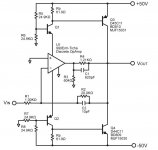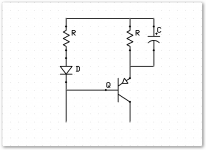An application for the DIY community I thought would be fun to share. Has some application for tube amps as well. If the verbage sounds a bit commercial or if the post violates the commercial rules I apologize. Not my intention. Its from an app note i wrote in October 2011.
A 990Enh-Ticha discrete opamp provides a low noise front end for this amplifier, which is capable of delivering over ±300mA to a load with a 90V peak-to-peak output swing. Transistors Q1 and Q2 are series regulators stepping down the supply voltage for the 990Enh-Ticha opamp to approximately ±24V, while transistors Q3 and Q4 provide the high current output drive. R3 and R4 form an output voltage gain stage whose gain, Av=3, is reduced to unity at high frequencies by C1 to maintain stability. The overall gain is set by R1 and R2. In the circuit example shown in PDF, the overall gain is 26dB (Av=20) with C2 setting the upper bandwidth 3dB point at 100kHz.
Q1 and Q2 should be capable of a continous current of 100mA and a Vce of at least 50V. For a margin of safety, attention should be paid to the transistors’ safe area operating regions. Q3 and Q4 are high current power transistors that will require heatsinks depending on load resistance. Several part types are called out in the schematic.
Power supply decoupling capacitors are not shown in the circuit diagram for operational clarity. 22uF low ESR electrolytic capacitors on the supply rails to ground are highly recommended. The 990Enh-Ticha opamp has 0.1uF capacitors at its VCC and VEE pins internally. Adding a small capacitor (100pF-1nF) across R6 and R7 can be helpful if the supply rails have ripple on them.
A 990Enh-Ticha discrete opamp provides a low noise front end for this amplifier, which is capable of delivering over ±300mA to a load with a 90V peak-to-peak output swing. Transistors Q1 and Q2 are series regulators stepping down the supply voltage for the 990Enh-Ticha opamp to approximately ±24V, while transistors Q3 and Q4 provide the high current output drive. R3 and R4 form an output voltage gain stage whose gain, Av=3, is reduced to unity at high frequencies by C1 to maintain stability. The overall gain is set by R1 and R2. In the circuit example shown in PDF, the overall gain is 26dB (Av=20) with C2 setting the upper bandwidth 3dB point at 100kHz.
Q1 and Q2 should be capable of a continous current of 100mA and a Vce of at least 50V. For a margin of safety, attention should be paid to the transistors’ safe area operating regions. Q3 and Q4 are high current power transistors that will require heatsinks depending on load resistance. Several part types are called out in the schematic.
Power supply decoupling capacitors are not shown in the circuit diagram for operational clarity. 22uF low ESR electrolytic capacitors on the supply rails to ground are highly recommended. The 990Enh-Ticha opamp has 0.1uF capacitors at its VCC and VEE pins internally. Adding a small capacitor (100pF-1nF) across R6 and R7 can be helpful if the supply rails have ripple on them.
Attachments
Last edited:
Don't want to burst your bubble, but this is an old technique. Also the bias current of the output transistors is not going to be accurate and will probably vary wildly with temperature.
my bubble is not burst. we can clearly add the cc sources and mirrors to lock down bias and compensate for temperature. it was originally intended to simply show an idea on how to run an opamp on a hv supply. i appreciate your pointing this out and i am interested in seeing how the online hive mind contributes to solving different engineering problems. My other post has similar short comings and again I hope to see how things unwind. be excellent!
Last edited:
There are some interesting high-voltage-output and current-boosted opamp circuits in AN18 at linear.com, and, in Figure 14 (which looks a lot like the OP's circuit) and Figure 33 of AN106 at linear.com, and, in AN-272 at national.com, where I particularly like the one with the McIntosh 75 tube amp inside the opamp's feedback loop.
in AN-272 at national.com, where I particularly like the one with the McIntosh 75 tube amp inside the opamp's feedback loop.
haha, do you think they were having a laugh?
I looked at AN-272. I too like the op-amp front end with the McIntosh tube amp as the booster/buffer! That's classic! I wonder how it sounds? I imagine the complete compound amp sounds pretty good, and could be real fodder for igniting the old solid vs. tube debate.
Figure 6 in that same AN is basically how virtually all Carver amps are constructed. Only they use a TL-072 as the front-end and voltage/current amplification discretely. They're noisy (Carver amps), but sure do belt out tons-of-power.
Regarding nerdman's original post, I've looked into similar designs, but by the time I get a real-world, usable design, the component count and complexity begins to rival a good-old discrete, diff-input power amp design. Albeit not a super high-quality design, but certainly something reasonable.
National's LME49810 is actually not too far off from your design and offers fantastic performance at very high supply rails with a pretty low component count to boot!
Figure 6 in that same AN is basically how virtually all Carver amps are constructed. Only they use a TL-072 as the front-end and voltage/current amplification discretely. They're noisy (Carver amps), but sure do belt out tons-of-power.
Regarding nerdman's original post, I've looked into similar designs, but by the time I get a real-world, usable design, the component count and complexity begins to rival a good-old discrete, diff-input power amp design. Albeit not a super high-quality design, but certainly something reasonable.
National's LME49810 is actually not too far off from your design and offers fantastic performance at very high supply rails with a pretty low component count to boot!
While the subject is up, does anybody remember what happened to the fairchild 78xx series of high voltage op amps (+-36v) in butterfly packages and heat tab packages? I had some samples the salesman gave me in 1978 before the Army got me,I built some things, when I tried to buy some last year the numbers were long forgotten. Now there are some TI heat tab op amps but they are pricey. I already know TI now owns national which bought fairchild.
As far as the tube amp versus transistor amp argument, there is no comparison. Tube amps will take a lighting strike from the power line. Transistor amps won't. How is your weather? I'm sick of unplugging the television, DVD, and computer all the time. I just leave the organ and ST70 plugged up, 44 years and a couple of power switches and turn off pop capacitors arced over only.
As far as the tube amp versus transistor amp argument, there is no comparison. Tube amps will take a lighting strike from the power line. Transistor amps won't. How is your weather? I'm sick of unplugging the television, DVD, and computer all the time. I just leave the organ and ST70 plugged up, 44 years and a couple of power switches and turn off pop capacitors arced over only.
Last edited:
I used National Semiconductor's LM343 high-voltage op-amp, but it's power bandwidth is only 20KHz. It would run up to +/- 34V which would make a nice little power amp with some current gain hung on the output, but still too slow. Burr-Brown (now owned by TI) makes some nice power op-amps, but for the highest performance, highest voltage op-amps, Apex Precision Power (owned by Cirrus Logic) makes units that operate up to 1,200V. Some of the Apex devices could be used for audio, but like my earlier comment, the cost of those units is so high, even used, you could make a nice discrete amp for less. They're still cool though!
±45V 15ma
http://www.ti.com/lit/ds/symlink/opa445.pdf
Cirrus Logic high voltage op-amps ( up to ±100V ) and High-Current Operational Amplifiers ( up to ±200V and up to 500W )
Power Operational Amplifiers - High-Current Operational Amplifiers, High-Speed Operational Amplifiers, High-Voltage Operational Amplifiers, Power Boosters
http://www.ti.com/lit/ds/symlink/opa445.pdf
Cirrus Logic high voltage op-amps ( up to ±100V ) and High-Current Operational Amplifiers ( up to ±200V and up to 500W )
Power Operational Amplifiers - High-Current Operational Amplifiers, High-Speed Operational Amplifiers, High-Voltage Operational Amplifiers, Power Boosters
Last edited:
- Status
- Not open for further replies.
- Home
- Amplifiers
- Solid State
- Hi Voltage Discrete Opamp Application

